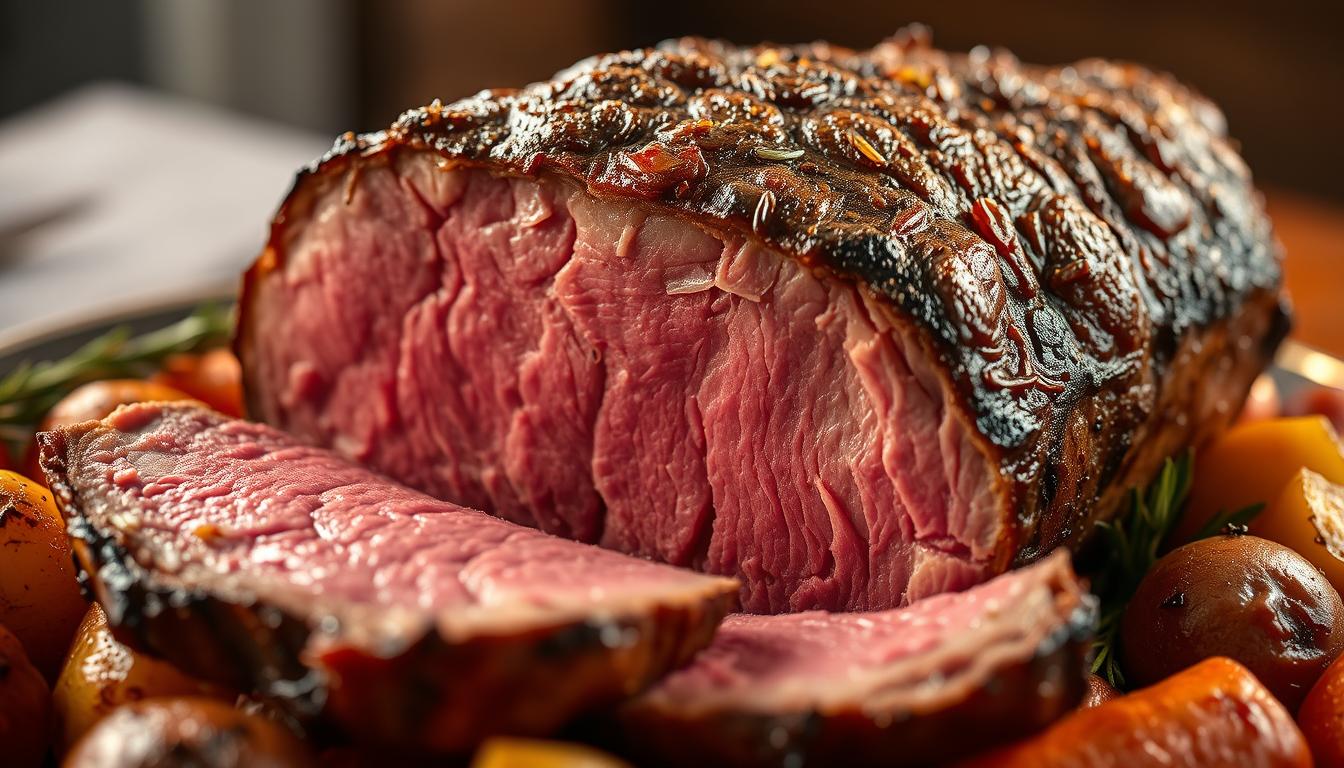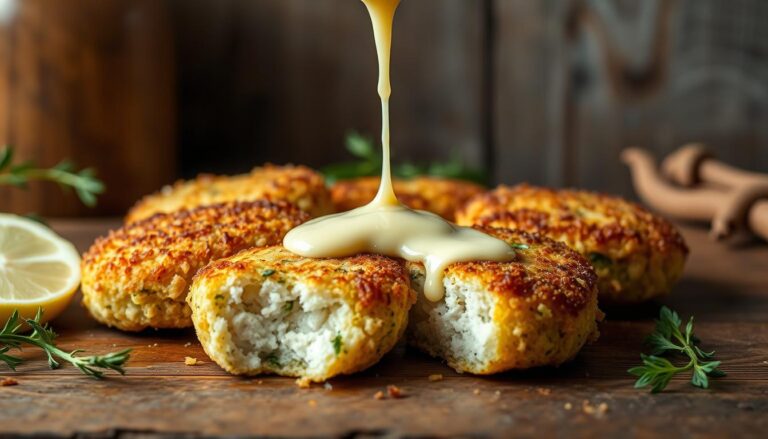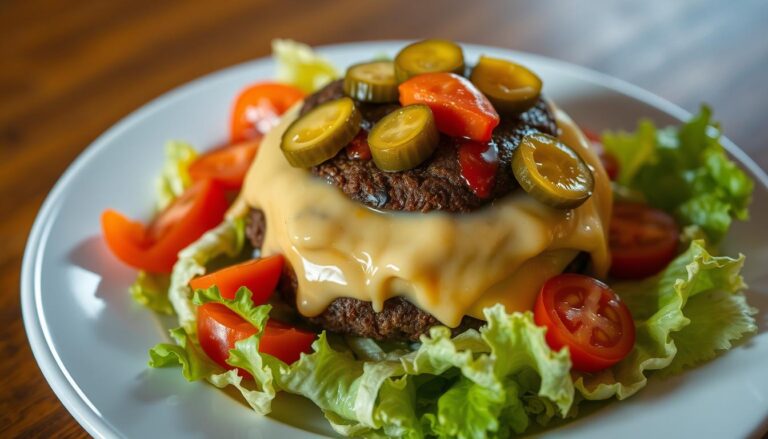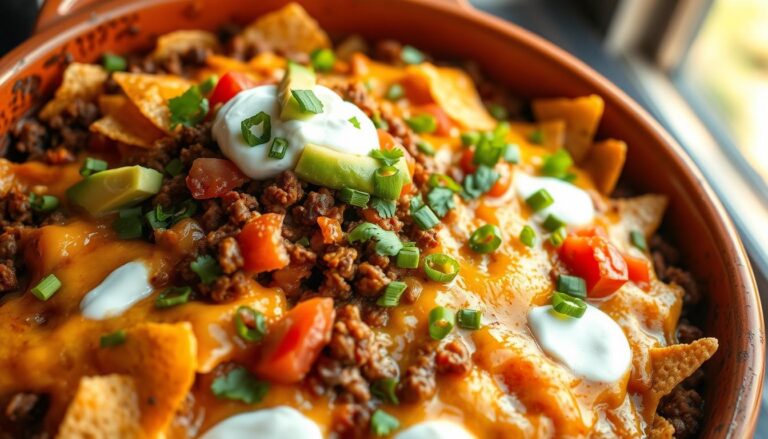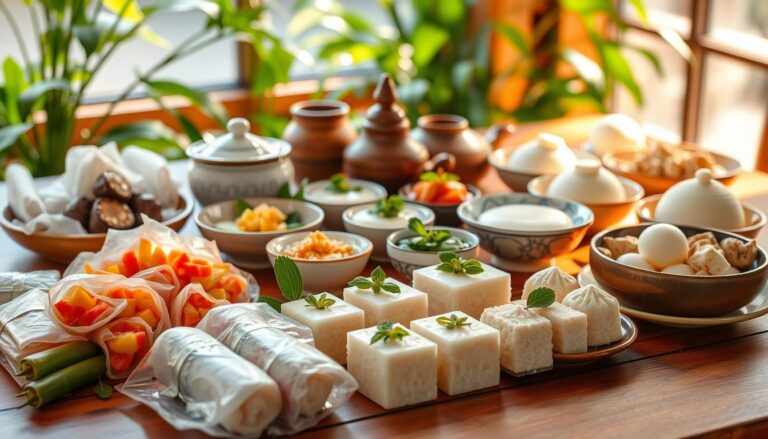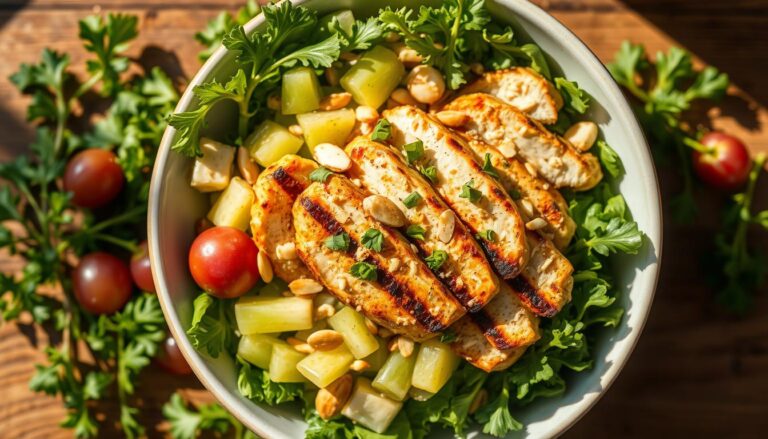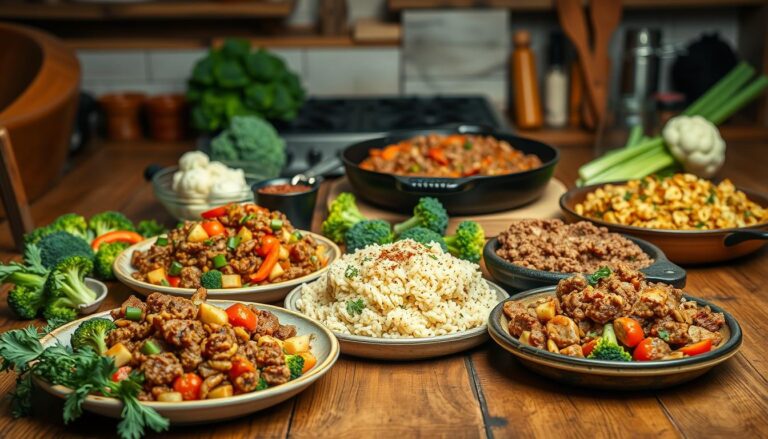Your Perfect Roast Beef Recipe
Imagine the dinner table filled with your loved ones. The smell of a roast makes everyone’s mouth water. A beef roast is a classic choice that always impresses. Making it perfect is simpler than you might think.
Creating a delicious dish is all about the right techniques. We’ll show you how to make a best roast beef recipe. From start to finish, we’ve got you covered.
Table of Contents
The Art of Roast Beef
To make perfect roast beef, you need to know about tenderness and flavor. Roast beef is a classic dinner loved for its rich taste and soft texture.
Why Roast Beef Remains a Classic Dinner Option
Roast beef recipe is loved for many reasons. It’s perfect for big events and cozy nights at home. Its tender meat and deep flavors come from careful cooking.
What Makes a Perfect Roast Beef
A perfect roast beef is tender and full of flavor. Two key things make it stand out:
Tenderness Factors
- Choosing the right cut of meat
- Cooking techniques that preserve moisture
- Allowing the meat to rest before carving
Flavor Development
Flavor in roast beef comes from:
- Proper seasoning
- Searing the meat to lock in juices
- Roasting at the right temperature and time
By paying attention to these details, you can make a roast beef that’s tender and full of flavor. It’s a true classic dinner experience.
Selecting the Best Cut for Your Roast Beef
Choosing the right cut of beef is key to a tender and tasty roast. The cut you pick greatly affects the roast’s flavor and texture.
Prime Cuts for Roasting
Prime cuts are tender and full of flavor. Here are some top picks:
- Ribeye Roast: Its marbling makes it tender and juicy.
- Tenderloin: A lean cut, perfect for those who want less fat.
- Prime Rib: Offers both tenderness and rich flavor.
Budget-Friendly Options
Looking to save money? There are still great choices:
- Chuck Roast: Flavorful and tender with slow cooking.
- Round Roast: Leaner and more affordable than chuck roast.
Understanding Meat Grades and Quality
Meat grades like Prime, Choice, and Select help you pick quality. “Prime is the highest grade, showing tender and well-marbled meat,” the USDA says.
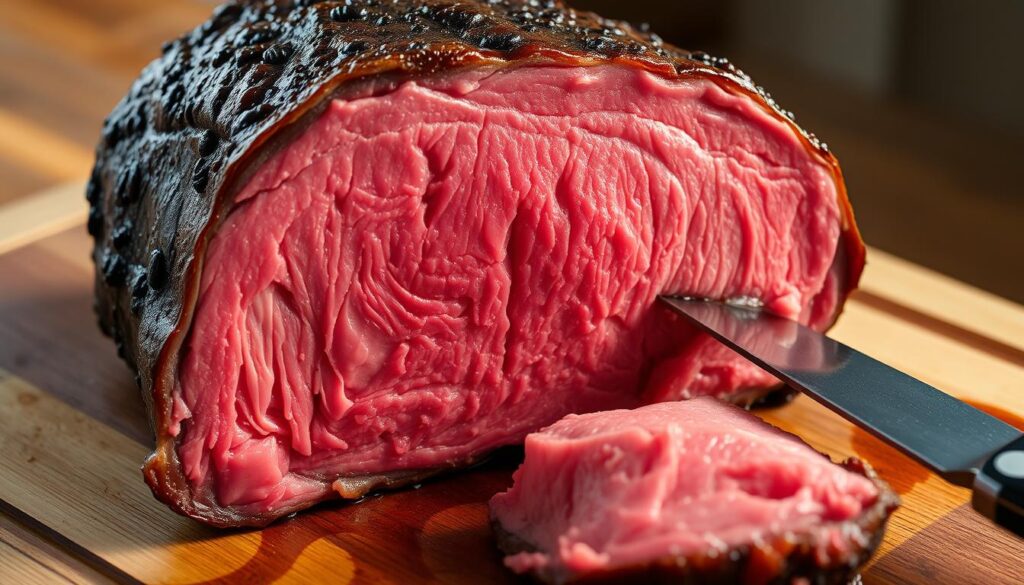
Essential Equipment for Perfect Roast Beef
To get perfect roast beef, you need more than just good meat. The right cooking tools are key. They make cooking easier and ensure your roast beef is tender, tasty, and perfectly cooked.
Roasting Pans and Racks
A heavy-duty roasting pan is essential. Choose one made from stainless steel or cast iron for even heat. A roasting rack inside the pan helps air circulate, ensuring even cooking and preventing steam.
Meat Thermometers
A meat thermometer is crucial for the right temperature. There are different types:
Digital vs. Analog
Digital thermometers offer quick, precise readings. Analog ones are traditional but still work well. Your choice depends on what you prefer and your budget.
Instant-Read vs. Leave-In
Instant-read thermometers are great for a quick check at the end. Leave-in thermometers track the temperature all the way through, helping you adjust cooking times.
Other Helpful Tools
Tools like a sharp knife for trimming and kitchen twine for tying the roast are useful. A carving fork and knife make serving easier.
| Equipment | Purpose | Key Features |
|---|---|---|
| Roasting Pan | Even heat distribution | Heavy-duty, stainless steel or cast iron |
| Roasting Rack | Air circulation around the meat | Fits inside roasting pan |
| Meat Thermometer | Accurate temperature monitoring | Digital or analog, instant-read or leave-in |
Ingredients for Classic Roast Beef
The key to a delicious roast beef is in its ingredients. To make a dish that stands out, start with the basics.
The Beef
The main ingredient is the beef. Choose a prime cut like a ribeye or top round. The quality of the beef greatly affects the taste.
Seasonings and Herbs
Seasonings and herbs are crucial for flavor. A mix of salt, pepper, and herbs can make the dish amazing.
Salt and Pepper Basics
Salt and pepper are essential. Use flaky sea salt and fresh black pepper for depth.
Herb Combinations
Herbs like thyme, rosemary, and parsley can be mixed for unique flavors. Try different combinations to find your favorite.
Optional Additions
There are extra ingredients to enhance your roast beef.
Garlic and Aromatics
Garlic and aromatics like onions and carrots add savory flavor. Just chop them and scatter them around the beef.
Wine and Broths
Wine or broth in the pan adds moisture and flavor. Choose red or white wine, or beef broth, based on your taste.
| Ingredient | Purpose | Options |
|---|---|---|
| Beef | Main ingredient | Ribeye, Top Round |
| Salt and Pepper | Seasoning | Flaky sea salt, Freshly ground black pepper |
| Herbs | Flavor enhancement | Thyme, Rosemary, Parsley |
| Garlic and Aromatics | Additional flavor | Onions, Carrots |
| Wine and Broths | Moisture and flavor | Red wine, White wine, Beef broth |
“The art of cooking is not just about following a recipe, it’s about understanding the ingredients and how they work together to create something truly special.”
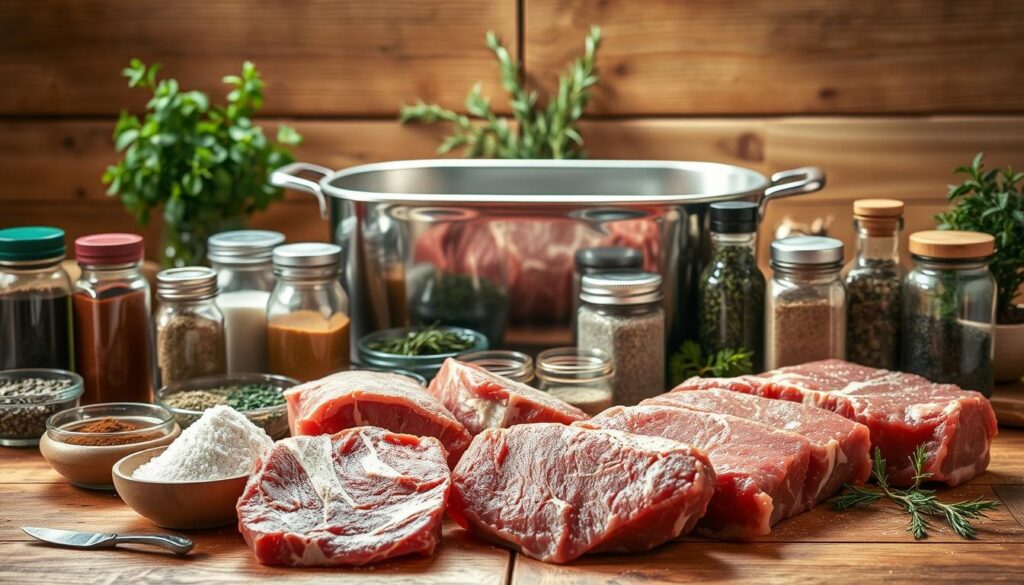
Preparing Your Beef for Roasting
Before you start roasting, it’s key to prepare your beef right. This ensures the best flavor and texture. A well-prepared roast beef is a must.
Bringing Meat to Room Temperature
Letting your beef warm up to room temperature is crucial. Take it out of the fridge and let it sit for 1-2 hours before roasting. This makes sure it cooks evenly.
Trimming and Tying Techniques
Removing excess fat prevents flare-ups. Tying the beef keeps it even and in shape. Use a sharp knife to trim fat, then tie it at intervals.
Seasoning Methods
Seasoning is a vital step in beef preparation. You can use dry rubs, marinades, or herb crusts.
Dry Rubs
A dry rub is a spice and herb mix rubbed on the beef. It adds flavor without extra moisture.
Marinades
Marinades soak the beef in a liquid mix. This includes acids, oils, and spices. It tenderizes and flavors the beef deeply.
Herb Crusts
An herb crust coats the beef with herbs, sometimes with breadcrumbs or cheese. It roasts to create a flavorful crust.
| Seasoning Method | Description | Benefits |
|---|---|---|
| Dry Rubs | Mixture of spices and herbs rubbed onto the beef | Adds flavor without extra moisture |
| Marinades | Beef soaked in a liquid mixture | Adds deep flavor and tenderizes the beef |
| Herb Crusts | Coating of herbs, sometimes with breadcrumbs or cheese | Adds a flavorful crust |
The Perfect Roast Beef Recipe Step-by-Step
Getting a perfect roast beef is all about the right steps. This guide will help you make a tender roast every time.
Preheating and Initial Setup
First, preheat your oven to 325°F (165°C). Make sure your roasting pan is ready. Use a rack if you have one to elevate the beef.
Searing Techniques
Searing the beef before roasting is key for flavor. Heat a skillet over high heat and add oil. Sear the beef on all sides until it’s browned. This step is crucial for better flavor and texture.
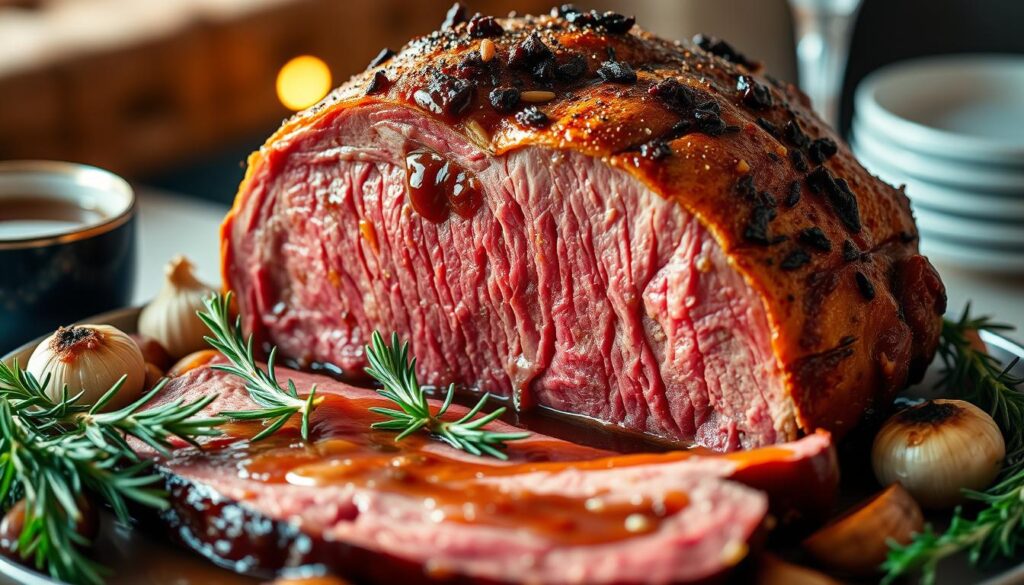
Roasting Process
After searing, place the beef in the roasting pan. Put it in the oven. The roasting time depends on the beef’s size and your desired doneness.
Testing for Doneness
Check the beef’s internal temperature with a meat thermometer. For medium-rare, aim for 130°F – 135°F (54°C – 57°C).
Temperature Guide for Different Levels
| Doneness Level | Internal Temperature (°F) | Internal Temperature (°C) |
|---|---|---|
| Rare | 120-125 | 49-52 |
| Medium Rare | 130-135 | 54-57 |
| Medium | 140-145 | 60-63 |
Visual Cues
You can also check doneness by looking at the meat’s color and feel. A rare roast is red and soft. A well-done roast is fully browned and firm.
By following these steps, you’ll get a perfectly cooked roast beef that you’ll love.
Mastering Different Cooking Methods
Learning various cooking methods can make your roast beef even better. You can choose from classic techniques or try something new. Each method can help you get the perfect roast.
Traditional Oven Roasting
Oven roasting is a classic way to cook roast beef. It gives a nice brown crust and a tender inside. First, heat your oven high, sear the beef, then roast at a lower heat until it’s just right.
Slow Roasting Technique
Slow roasting cooks the beef at a low heat for a long time. It’s great for making tough cuts tender. This method is easy and lets you relax while it cooks.
Reverse Sear Method
The reverse sear starts with low heat, then sears at high heat. This way, your roast is evenly cooked and has a crispy crust.
Special Equipment Methods
Special tools can make your roast beef even better. Sous vide machines control the temperature perfectly. Convection ovens cook faster and brown better.
Sous Vide and Roasting Combination
Using sous vide and roasting together is a great idea. Sous vide cooks the beef to your liking, then sear it in a hot pan for a nice crust.
Convection Oven Adjustments
Convection ovens cook faster, so lower the temperature by 25°F (15°C). Keep an eye on the roast to avoid overcooking.
Creating the Perfect Gravy and Sauces
To complete your roast beef dish, a delicious gravy or sauce is essential. The pan drippings from your roast beef are a treasure trove of flavor. They wait to be transformed into a rich, savory gravy.
Using Drippings
The first step in making gravy is to utilize the pan drippings. After roasting, remove the beef from the pan and set it aside to rest. The remaining drippings in the pan are packed with flavor.
Thickening Methods
There are several methods to thicken your gravy, including flour-based gravies and reduction techniques.
Flour-Based Gravies
To make a flour-based gravy, mix equal parts of flour and fat (from the drippings) to create a roux. Gradually add broth or stock, whisking continuously to avoid lumps.
Reduction Techniques
Alternately, you can reduce the gravy by simmering it gently. This allows the liquid to evaporate and the flavors to concentrate.
| Thickening Method | Description | Best For |
|---|---|---|
| Flour-Based | Creates a roux with flour and fat, then adds liquid. | Thick, hearty gravies. |
| Reduction | Simmers the gravy to reduce liquid and intensify flavor. | Clear, flavorful gravies. |
Flavor Enhancements
You can further enhance your gravy’s flavor by adding herbs, spices, or a splash of wine. Experiment with different combinations to find your perfect match.
Alternative Sauce Options
Besides traditional gravy, consider alternative sauces like horseradish cream or red wine reduction. These add variety to your roast beef.
Horseradish Cream
Mixing horseradish with sour cream or yogurt creates a tangy, creamy sauce. It pairs well with roast beef.
Red Wine Reduction
Reducing red wine on the stovetop concentrates its flavors. This makes a rich, fruity sauce to accompany your roast beef.
Resting and Carving Your Roast Beef
To make your roast beef tender, you need to rest and carve it right. Resting lets the juices spread out, making the beef taste better and feel softer.
Why Resting Is Crucial
Resting your roast beef after cooking is key. The heat makes the proteins tighten and juices move to the surface. Letting it rest lets these juices spread out, making the meat tender and juicy.
Proper Carving Techniques
Carving your roast beef right is as important as cooking it well. Here are some tips:
- Slicing Against the Grain: Always slice your roast beef against the grain to ensure tenderness.
- Thickness Considerations: The thickness of your slices can affect the overall dining experience. Thicker slices retain more juices, while thinner slices are easier to chew.
Slicing Against the Grain
Slicing against the grain means cutting the meat in a direction perpendicular to the lines of muscle fibers. This makes the meat more tender and easier to chew.
Thickness Considerations
The ideal slice thickness depends on personal preference and the type of roast. For a prime rib, thicker slices are often preferred, while for a top round, thinner slices might be more suitable.
Presentation Tips
The way you present your roast beef can make a big difference. Arrange your slices on a platter in a way that looks good. Add fresh herbs or roasted vegetables for extra flavor and color.
Side Dishes That Complement Roast Beef
Choosing the right side dishes can make your roast beef meal even better. It’s all about finding the right balance of flavors and textures. This ensures a great dining experience.
Traditional Accompaniments
Horseradish sauce and au jus are classic choices that go well with roast beef. They add a tangy and savory touch to your meal.
Vegetable Options
Vegetables offer a nice contrast to the rich roast beef. Here are some great options:
Roasted Vegetables
Roasted carrots, Brussels sprouts, and parsnips are a tasty match. Just toss them with olive oil, salt, and pepper. Roast in the oven until they’re tender.
Fresh and Light Sides
For a lighter choice, try a simple green salad or steamed green beans. They offer a refreshing contrast to the roast beef.
Starch Pairings
Starches are a key part of many roast beef meals. Here are some favorites:
Yorkshire Pudding
Yorkshire pudding is a traditional British side dish that goes great with roast beef. It’s light, airy, and soaks up the juices well.
Potato Variations
Potatoes are very versatile. You can roast them, mash them, or make a potato gratin. They all pair well with roast beef.
| Side Dish | Description |
|---|---|
| Roasted Vegetables | Carrots, Brussels sprouts, and parsnips roasted with olive oil and seasoning. |
| Yorkshire Pudding | A traditional British dish, light and airy, perfect for absorbing roast beef juices. |
| Mashed Potatoes | Creamy mashed potatoes, a comforting side dish that pairs well with roast beef. |
“The right side dishes can make or break the overall dining experience. For roast beef, traditional accompaniments like horseradish sauce are hard to beat.”
By adding these side dishes, you can make a meal that will impress your guests. It’s a well-rounded and satisfying experience.
Storing and Using Leftover Roast Beef
Leftover roast beef is great for many tasty meals. It’s important to handle and store it right to keep it good.
Proper Cooling and Storage
Cool leftover roast beef to room temperature in two hours. Slice it against the grain and put it in a sealed container. You can keep it in the fridge for 3-4 days or freeze it for later.
Reheating Methods That Maintain Moisture
Reheat it on low heat to avoid drying out. You can reheat it in the oven, wrapped in foil, or in a sauce or gravy.
Creative Leftover Recipes
Turn leftover roast beef into new dishes. Here are some ideas:
- Sandwiches and Wraps: Slice the roast beef thinly and put it on a crusty roll.
- Salads and Bowls: Mix diced roast beef with greens, veggies, and your favorite dressing.
- Soups and Stews: Cook the roast beef with veggies and broth for a warm soup.
Conclusion
Now you know about roast beef, from picking the right cut to cooking it well. The secret to great roast beef is knowing how to cook and trying new things.
Keep working on your roast beef recipe. Try different seasonings and cooking times to find what works best. With these cooking tips, you’ll make a roast beef that everyone will love.
Getting perfect roast beef takes time, patience, and paying attention to details. Follow the steps in this article and don’t be afraid to try new things. You’ll soon make a delicious roast beef that will be a favorite in your kitchen.

